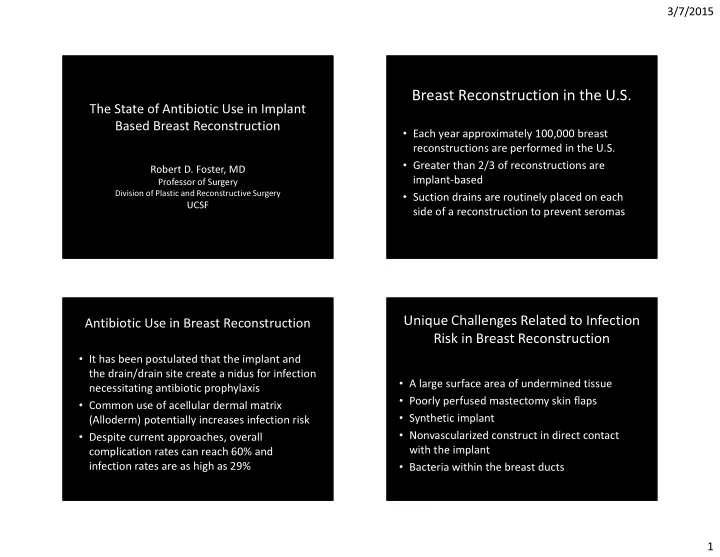

3/7/2015 Breast Reconstruction in the U.S. The State of Antibiotic Use in Implant Based Breast Reconstruction • Each year approximately 100,000 breast reconstructions are performed in the U.S. • Greater than 2/3 of reconstructions are Robert D. Foster, MD implant-based Professor of Surgery Division of Plastic and Reconstructive Surgery • Suction drains are routinely placed on each UCSF side of a reconstruction to prevent seromas Unique Challenges Related to Infection Antibiotic Use in Breast Reconstruction Risk in Breast Reconstruction • It has been postulated that the implant and the drain/drain site create a nidus for infection • A large surface area of undermined tissue necessitating antibiotic prophylaxis • Poorly perfused mastectomy skin flaps • Common use of acellular dermal matrix • Synthetic implant (Alloderm) potentially increases infection risk • Nonvascularized construct in direct contact • Despite current approaches, overall with the implant complication rates can reach 60% and infection rates are as high as 29% • Bacteria within the breast ducts 1
3/7/2015 Difficulty in Analyzing Breast Unique Challenges Related to Infection Risk in Breast Reconstruction Reconstruction Data • Lack of uniformity in the approach to • Seroma risk mastectomy and reconstruction • Drain and drain site opening • No randomized prospective data • The need for chemotherapy and/or • Widely divergent approach to antibiotic use radiation before or after mastectomy • Very broad range of infection rates within • Radiation delivered directly to the each antibiotic regimen surgical site Current State of Implant Based Breast Difficulty in Analyzing Breast Reconstruction Reconstruction Data • Based on surveys of plastic surgeons Phillips et al, 2011 Brahmbatt et al, 2012 • Variables that may influence outcomes – Thickness of mastectomy flaps – >80% always use drains – Incidence of skin necrosis – >70% use acellular dermal matrix – Preservation of nipple/areola – >60% always use postoperative antibiotics – Use of acellular dermal matrix – 50% use antibiotics for a standard time (5-7 days) – 50% use antibiotics until drains out 2
3/7/2015 Literature Review of Prophylactic Antibiotic Use Current General Practices and Data for in Surgical Patients Implant Based Reconstruction • Studies suggest that >24 hour postoperative prophylactic antibiotics not indicated in routine clean • No current consensus on postop antibiotic use surgical procedures (Hawn, et al, 2011) • Most common practice perioperative followed • Prophylactic antibiotics significantly reduce the incidence of surgical site infection in breast surgery by either 5-7 day use or until drains removed without reconstruction (Cunningham, et al, 2006) • Published surgical-site infection rates: 1-24% • Randomized clinical trials in breast reconstruction • No clear consensus on how to report infection patients show significantly lower infection rates with rates prophylactic antibiotics (Amland, et al, 1995) Antibiotic Prophylaxis and Infection Risk in Antibiotic Prophylaxis and Infection Risk in Expander/Implant Reconstruction Expander/Implant Reconstruction • Clayton, et al. UNC Surgical Improvement Program – despite increasing use of • Clayton et al., 2012 prophylactic antibiotics, no corresponding – 250 patients decrease in infection rates – Overall rate of surgical site infections increased • One year protocol of a single preoperative from 18% to 34% dose of antibiotics for all patients undergoing – Infections requiring reoperation increased from breast reconstruction compared to a group 4% to 16% the year prior who received antibiotics until drains were removed 3
3/7/2015 UCSF Experience Antibiotic Prophylaxis and Infection Risk in Expander/Implant Reconstruction Expander/Implant Reconstruction • Greater than 400 reconstructions each year • Clayton et al., 2012 • Antibiotics continued until drains removed – Multivariate logistic regression: Preoperative-only • 17% overall incidence of infection antibiotic group 4.74 times more likely to develop • 22% incidence of infection in radiated px surgical-site infection requiring reoperation – Preoperative-only antibiotic group 3.77 times • Majority of infections resolved with PO more likely to require removal of the tissue antibiotics expander/implant • 5% risk of implant loss Steps Taken at UCSF to Reduce Total Skin Sparing Mastectomy (preoperative photo) Infection Rates • Barrier between the skin and the prosthesis during placement • Changing gloves prior to placement • Alternative incisions with a h/o radiation • Delaying implant placement when radiated • Vigilant diagnosing and draining seromas – Strong cooperation with our colleagues in ultrasound and IR 4
3/7/2015 Left mastectomy completed 2 mm skin flaps Translucent Skin Flaps Protective barrier preventing skin contact 5
3/7/2015 Evaluating the Consequence of Breast Left expander reconstruction completed Reconstruction Failure • Why are we so concerned about the outcome of a non-life threatening scenario • Why are we willing to put patients at risk for health issues in the future • Need to explore the social significance of the breast as a body part and appreciate the impact of not having one or both 6
Recommend
More recommend